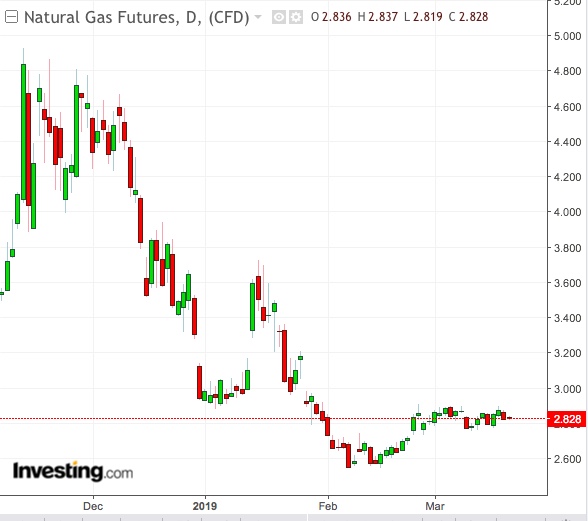Spring’s here—and like the ritual cleaning that comes with the season, it’s time to dust the natural gas trading books of positions, as well as projections, that didn’t or aren’t
quite likely to make it.
But first, there’s another weekly dataset and inventory draw to get out of the way.
The U.S. Energy Information Administration is likely to report at 10:30am ET (14:30pm GMT) today that gas stockpiles fell by 48 billion cubic feet last week, in what would be one of the few remaining weeks of net storage drawdown by utilities that are burning gas to run heaters, still providing insulation from the remnants of the winter season cold.
Latest Drawdown Less Than Half Of Previous Week?
The 48-bcf draw estimate from analysts polled by Reuters will be markedly smaller than the 87-bcf withdrawal from a year ago, and slightly below the average consumption of 56 bcf typical for this time of year over the past five years. The estimate for the week ending March 15 is also a fraction of the 204 bcf withdrawn during the week to March 3, when a blast of super cold struck the U.S. Northeast and other gas-fired heating zones.
According to Reuters, there were just 124 heating degree days last week, compared with 150 HDDs in the same week a year ago and a 30-year normal of 135 HDDs for the period. HDDs measure the number of degrees a day's average temperature is below 65 Fahrenheit (18 Celsius) and are used to estimate demand to heat homes and businesses.
While still a preliminary estimate, this week’s heating use may be as low as 33 bcf, compared with the year-ago consumption of 66 bcf and the five-year average of 41 bcf, the Reuters poll showed.
What do all these mean for natural gas prices?
Lower Chance Of $3 Gas Happening Soon

According to Dominick Chirichella, director of risk and trading at the DTN-owned Energy Management Institute in New York, the fast-evolving warmth means even lesser chance of $3 gas in the “shoulder season”—the winter-to-summer transition, a period often marked with mild weather that barely triggers intense heating or cooling demand.
Said Chirichella in an outlook issued Wednesday:
“The high Nat Gas demand winter weather is now in the history books as spring-like weather is moving into parts of the country.”
“Even if there are surprise bursts of cold temperatures, it is not likely to be cold enough to send Nat Gas prices spiraling higher in the short term.”
In Wednesday’s trade, benchmark Henry Hub gas futures for April on the New York Mercantile Exchange settled down 5.4 cents, or 2%, at $2.82 per million British thermal units.
Technicals Show 'Neutral' View
Chirichella said despite defensive trading by natural gas bulls seen on Wednesday against the warm-up underway, April gas couldn’t get over the psychological $3 per mmbtu mark, opening the possibility hereon of “technical trading range boundaries at $2.737 on support and $2.90 on the resistance”.
Technical analysts at Investing.com have a somewhat similar “Neutral” view on April gas, pegging Level 3 Fibonacci support at $2.781 and corresponding top-end resistance at $2.901.
But some analysts are more confident about gas demand in the coming weeks.
Dan Myers of Houston-based gas market consultancy Gelber & Associates said although smaller weekly gas withdrawals would be the norm hereon, the huge deficit in the fuel’s stockpiles lately means the summer will open with a smaller reserve. That could be worrying if demand for cooling turns out to be as aggressive as that for heating during the winter.
Pre-Summer Stockplies Sharply Down
According to Reuters, a 48-bcf withdrawal for last week will leave total gas in storage at 1.138 trillion cubic feet. That’s about 22% below the year-ago level and some 33% under the five-year average.
Said Myers:
“The spring shoulder season may have to wait a little longer as demand stays steady and requires net withdrawals from storage to supplement production through the end of the month.”
“This would keep the pressure on prices going into April.”
According to forecasts by Chirichella’s DTN, “above and much-above normal temperatures” were possible from the interior West eastward of the United States over the next 11 to 15 days. But the agency also alluded to colder-than-normal temperatures in the central and eastern U.S. for at least a few days after the start of the 6-10-day period.
That raises the possibility of gas prices not taking too much of a hit below $2.80 in the coming weeks, as Myers believed.
Be Prepared For More Range-Bound Trading
Scott Shelton, energy futures broker and commentator at ICAP (LON:NXGN) in Durham, N.C., advises players to hunker down for more range-bound conditions.
Said Shelton:
“We have tested the downside and upside this month with little follow-through. It may take until the middle of next month to get out of the range after the market digests a few weeks of injection data and also digests the eventual return of freeze-off generated production losses in the Rockies.”
